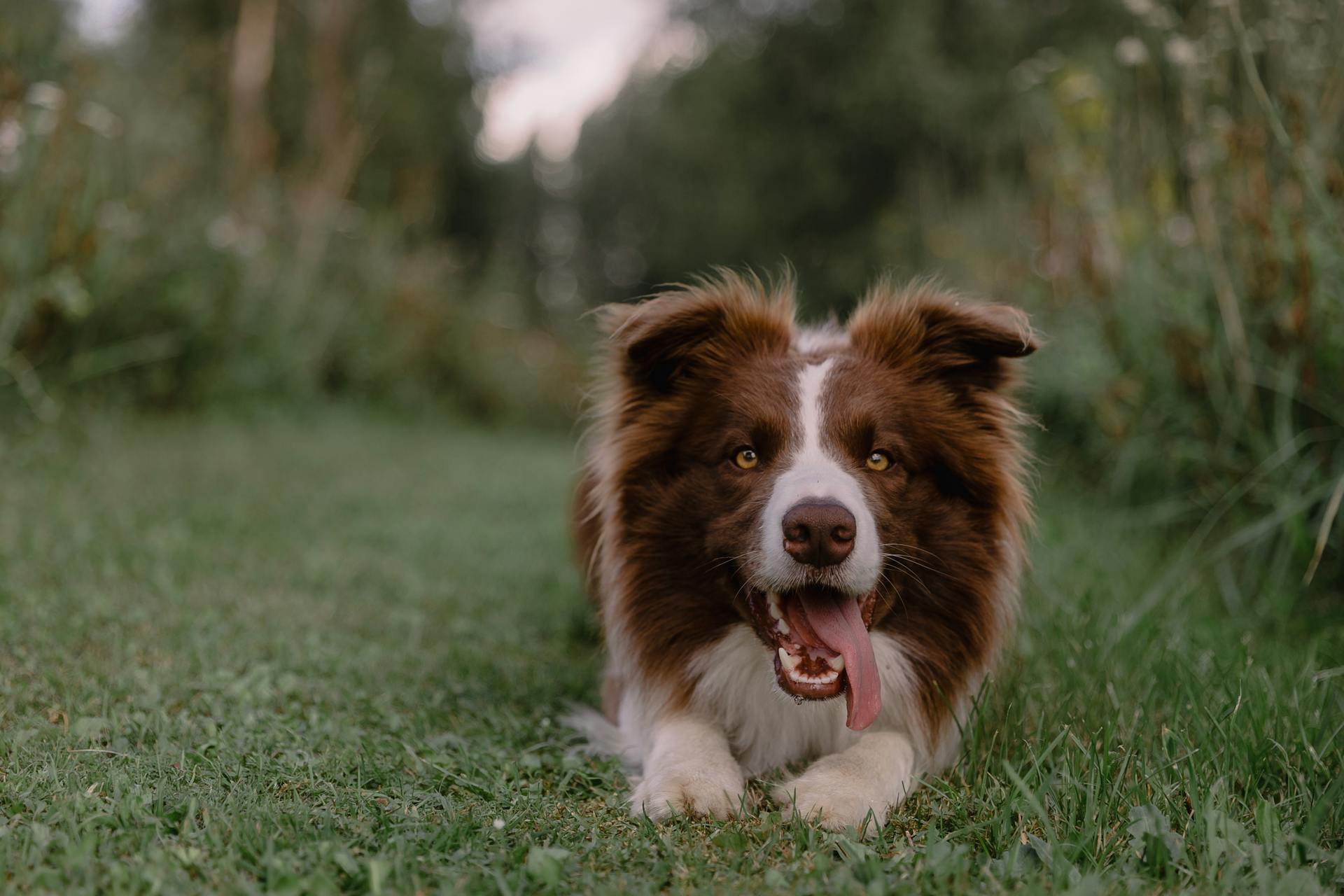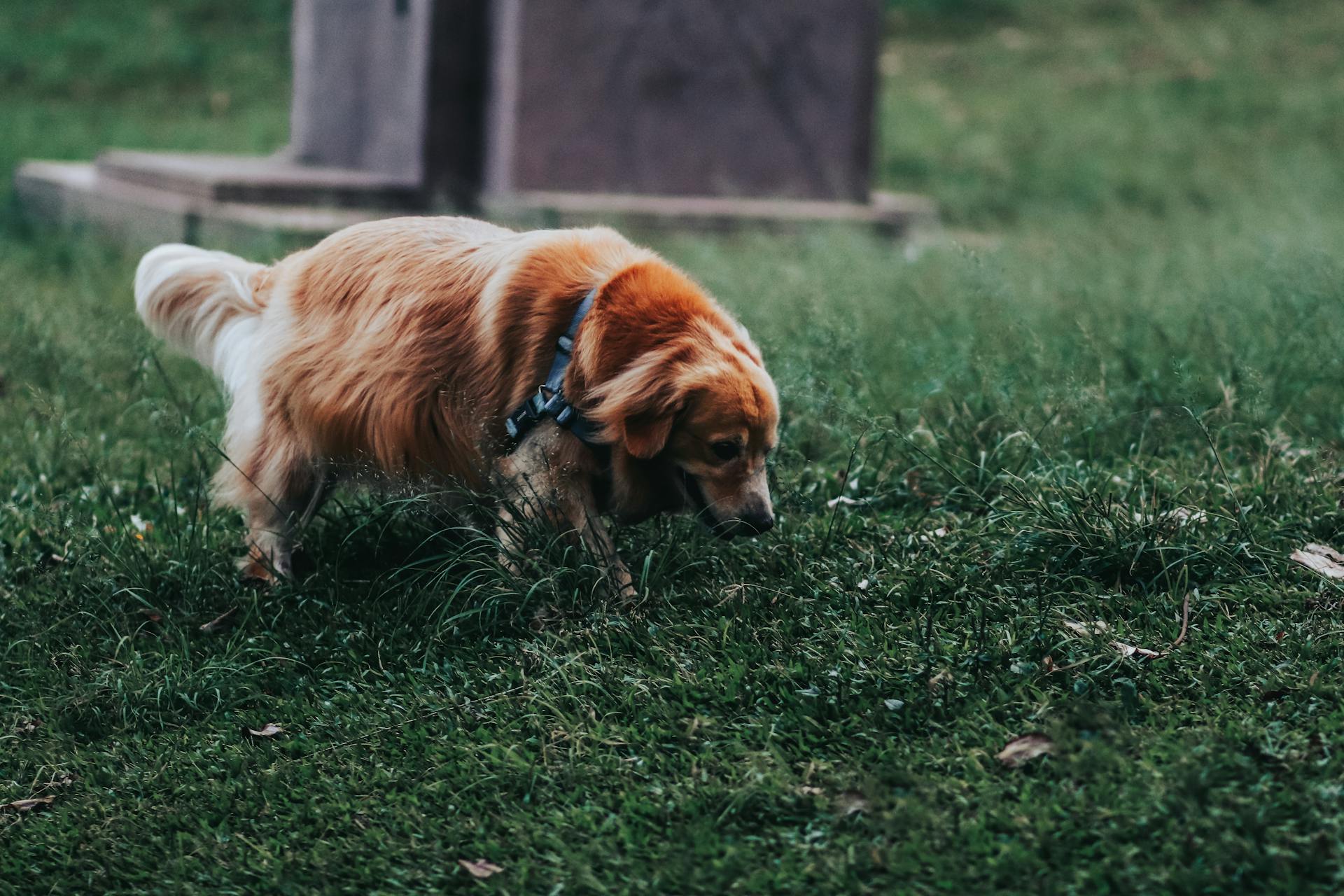
Canine dominance behavior is a natural phenomenon that can be both fascinating and intimidating. Dominant dogs often display assertive body language, such as raised hackles and direct stares.
In the wild, dominant dogs assert their status through vocalizations, like growling and barking. This behavior helps them establish a pecking order within their pack.
However, in a domestic setting, canine dominance behavior can be misinterpreted as aggression or even fear. It's essential to recognize the difference and address the underlying causes.
By understanding canine dominance behavior, we can better manage it and create a more harmonious living environment for both humans and dogs.
Related reading: Dominant Female Dog
Understanding Canine Dominance
Canine dominance behavior is a complex and multifaceted topic, but at its core, it's about establishing a hierarchy within a pack. This hierarchy is essential for the well-being and survival of the pack.
Dominant dogs often exhibit assertive body language, such as a raised head, stiffened posture, and direct eye contact. They also tend to be more vocal, using growls, snarls, and barks to assert their dominance.
A dominant dog's presence can be felt by other dogs, and they often take the lead in situations like walking or playing. They may even try to push their way to the front of the pack or claim the best spot on the couch.
In canine packs, dominance is often determined by factors such as age, size, and temperament. For example, a larger dog may be more likely to dominate a smaller dog due to its physical strength and size.
Dominant dogs can be challenging to live with, but they can also be loving and loyal companions. With patience, consistency, and positive reinforcement training, it's possible to teach a dominant dog to respect boundaries and coexist peacefully with other dogs and humans.
Causes and Triggers
Canine dominance behavior can be triggered by a lack of proper socialization in the first 16 weeks of life, which can lead to fear and aggression issues later on. This is a critical period for puppies to learn important social skills.
Some breeds, such as those with a strong prey drive like the Greyhound and Whippet, may be more prone to dominance behavior due to their instincts.
A change in family dynamics, such as the addition of a new baby or another pet, can also trigger dominance behavior in dogs.
When Does It Start?

Dominance behavior in dogs is extremely rare in puppies younger than 10 months of age. In my 35 years of breeding working bloodline German Shepherds, I've never seen a case of a puppy showing signs of dominant handler aggression that young.
Puppies under 10 months old are still learning how to interact with their human pack, and it's not until they've established a clear understanding of rank that dominance issues typically arise. Unfortunately, new puppy owners often mistake prey drive for dominance, leading to frustration and confusion.
Puppies naturally exhibit prey drive by playing with their littermates, using their mouth to bite and growl at each other. This behavior can be mistaken for dominance, but it's actually just a normal part of puppy development.
In fact, a puppy's prey drive is a sign of its high energy and drive, but it's not a sign of dominance. The key is to teach the puppy manners and human rules, redirecting its energy towards acceptable outlets like toys and treats.
Consider reading: Dog Aggression during Human Pregnancy
Poor Obedience is a Cause
Poor obedience training is a significant cause of dominant dog problems. Ineffective obedience training can lead to dominance issues with maturing dogs.
Many obedience classes only teach the Learning Phase, which involves teaching a dog the meaning of a command in a distraction-free environment. However, they often skip the Correction Phase, which is essential for teaching a dog that it will be corrected if it doesn't follow a command.
The Correction Phase involves teaching a dog that it will be corrected if it doesn't follow a command it has already learned. This phase is crucial for adult dogs, as it helps establish clear boundaries and consequences. Without it, dogs may not learn to respect their owner's authority.
In fact, almost all large pet warehouse classes skip the Correction Phase, which is one of the leading causes of dominant dog problems. This is because they focus on teaching obedience skills without addressing the underlying issues of dominance and submission.
On a similar theme: How to Discipline a Dog That Doesn't Listen
To avoid this problem, it's essential to find an obedience class that teaches both the Learning Phase and the Correction Phase. This will help your dog learn to respect your authority and follow commands consistently.
Here are the three stages of obedience training that every dog needs:
- Learning Phase: Teaching a dog the meaning of a command in a distraction-free environment.
- Generalization Phase: Teaching a dog to generalize the behavior in more and more environments and under more and more distractions.
- Correction Phase: Teaching a dog that it will be corrected if it doesn't follow a command it has already learned.
Recognizing Dominance Behavior
Dominance behavior in dogs is a natural aspect of their social structure, originating from their ancestral background as pack animals.
Inappropriate mounting, licking, being demanding, or begging are common dominant behaviors in dogs that can illustrate a dog's attempt to assert itself as the "pack leader" within a household.
These behaviors may seem harmless at first, but they can be a sign that your dog is trying to take control.
Dogs may also exhibit dominant behavior by guarding toys, laying on the bed or on the furniture whenever they want, which can be a sign that they're asserting their rank within the pack.
Recognizing these behaviors early on can help you maintain a harmonious and balanced relationship with your pet.
Shows Maturity (15 to 36 Months)
Dogs typically show maturity between 15 and 36 months of age, with most common around 18 months. This is a critical period where their instincts take over, and they start to assume a rank within the pack.
As they mature, dogs may begin to assert physical control, constantly leading during walks or pushing their owners around. This is a clear sign that they're trying to establish dominance.
If a dog is not receiving proper training or is allowed to display rank behavior, such as guarding toys or laying on furniture, their drive to assume higher pack position takes over. This can lead to serious dominance or handler aggression problems.
Excessive barking or growling, disobedience, and aggressive body language can signal dominance issues in dogs. These behaviors are often possessive, targeting food, toys, and even family members.
Signs of an Alpha
Recognizing the signs of an alpha dog is crucial in understanding their behavior and maintaining a harmonious relationship with them. An alpha dog typically displays confidence and leadership qualities.
Recommended read: Alpha Female Dog
One of the key signs of an alpha dog is maintaining a calm demeanor, which is essential in a pack leader. They also control resources such as food and toys, and initiate play with other dogs. An alpha dog often displays assertive body language, which can be a warning sign that they are ready to assert their dominance.
In a pack, leaders eat what they want and get the better sleeping quarters. Lower-ranking members would not challenge the leader for food or act aggressively towards a higher pack member by trying to move the leader out of his bed. This social rank is a big thing to a pack animal.
A dog that displays these characteristics is not necessarily aggressive, but rather confident and assertive. In fact, growling can be a signal that there is a problem of some kind, and it's often accompanied by other subtle body postures that most owners miss.
Here are some key signs of an alpha dog:
- Maintaining a calm demeanor
- Controlling resources
- Initiating play with other dogs
- Displaying assertive body language
- Eating what they want and getting the better sleeping quarters
By recognizing these signs, you can establish a stronger bond with your dog and understand their behavior better.
Asserting Boundaries and Control
Asserting boundaries and control is crucial in managing canine dominance behavior. It's essential to establish clear limitations on your dog's behavior and consistently enforce these rules.
Controlling your dog's environment is the first step in preventing dominant behavior. This means avoiding situations that can lead to aggression, such as sleeping in bed with your owner, pushing people to pet them, or resisting laying down when told to down.
Consistency and boundaries are key in managing dominant behavior. Establishing clear rules and enforcing them consistently helps reinforce your position as the authority figure in the household. This also fosters respect and trust between you and your dog.
Dogs assert dominance over other dogs through various behaviors, such as mounting, standing over another dog, or placing their head or paw on the other dog's body. Dominance can also be displayed through aggressive body language, like raised hackles, direct eye contact, or baring teeth.
For more insights, see: When Do Labradors Calm down
Some signs that your dog is showing dominance over you include refusing to come when called, persistently climbing onto your bed and couch despite your objections, or displaying aggression towards you.
Controlling the food is a crucial aspect of asserting boundaries and control. Your dog needs to know that you control the food and everything that comes with eating, including mealtimes, scraps, and eating habits.
Here are some common mistakes to avoid when asserting boundaries and control:
- Allowing your dog to rule the house
- Letting your dog make decisions
- Not being firm with your rules and boundaries
- Lack of consistency in rules and boundaries
By avoiding these mistakes and consistently enforcing rules and boundaries, you can help manage your dog's dominance behavior and establish a harmonious relationship.
Training and Correction
To correct dominant behavior in dogs, it's crucial to establish clear boundaries and provide consistent training. Reinforcing desired behaviors with rewards, such as treats and praise, can effectively reshape your dog's behavior.
Consistency is key when attempting to correct dominance behaviors in dogs. Consistent enforcement of rules and boundaries aids in managing dominant behavior, and dog owners should establish clear limitations on their pets' behavior and consistently enforce these rules.
To address dominant behavior, it's essential to address the initial signs of dominance promptly with appropriate training and correction. Ignoring these early warning signs can allow the problem to escalate. Some common signs of dominance include pushing their way to the front during walks, growling when asked to give up a toy, or attempting to claim your personal space.
Here's a summary of the correction phases of training:
- Learning Phase: The dog is taught the meaning of a command in a distraction-free environment through motivational methods.
- Generalization Phase: The behavior is taught in more and more environments and under more and more distractions.
- Correction Phase: The dog is taught that it will be corrected if it does not follow a command that it has learned during the Learning Phase.
Remember, every dog is different, and what works for one dog may not work for another. Be patient and persistent, and with the right approach, you can help your dog overcome dominant behavior.
What Does 'Heel' Mean?
To start training your dog to walk by your side, you need to understand what "heel" means in dog training. "Heel" refers to the desired position of your dog when walking on a leash, where they walk beside you without pulling.
By providing a clear definition, you can begin to teach your dog to heel effectively. The goal is to have your dog walk by your left side, with their head held high and their leash loose.
Related reading: Training Dog to Heel
To achieve this, you'll need to practice walking with your dog in a controlled environment, such as a quiet street or park. This will help them learn to walk by your side without distractions.
Consistency is key when teaching your dog to heel. Make sure to reward good behavior and correct bad behavior promptly. This will help your dog learn faster and stay focused on the task at hand.
If this caught your attention, see: Will Spaying Help with Dog Aggression
Handler Mistakes
Handler mistakes often begin with a misunderstanding, where pet owners are led to believe that obedience classes will result in a well-mannered dog, but these classes often fail to teach owners that dogs need rules to live by.
Pet owners need to learn the importance of consistency and varying levels of consequences, as well as teaching their dogs to be polite around strangers, leave small children alone, and not jump up on people or take food off the counter.
Local obedience instructors may not emphasize the need for rules and consistency, leading owners to underestimate the complexity of dog behavior and training.
A unique perspective: Shock Collar Pet Trainer
In fact, owners often don't learn that their dog needs rules to live by, which can lead to a lack of clear boundaries and expectations in the household.
Consistency and clear boundaries are crucial in managing dominant behavior in dogs, and owners should establish clear limitations on their pets' behavior and consistently enforce these rules.
Direct eye contact with a dominant dog can be interpreted as a challenge, so it's essential to maintain an assertive, but non-confrontational, posture during training sessions or when issuing commands.
Establishing consistent boundaries not only helps curb dominant behavior but also fosters respect and trust between the dog and its owner.
By consistently enforcing limitations and promoting submission, dog owners can create a harmonious environment where both they and their pets can thrive.
If this caught your attention, see: Dog Obedience Classes and Trainers for Well-behaved Pets Scottsdale
Correcting
Correcting dominant behavior in dogs requires patience, persistence, and a clear understanding of canine behavior. Establishing clear boundaries and providing consistent training is crucial to reshape your dog's behavior.
Reinforcing desired behaviors with rewards, such as treats and praise, can effectively correct dominant behavior. It's essential to address the initial signs of dominance promptly to prevent them from becoming ingrained patterns.
Ignoring early warning signs can allow the problem to escalate, so it's crucial to address them with appropriate training and correction. Using timeouts can be an effective way to nip these behaviors in the bud.
To correct dominant behavior, it's essential to understand that growling is not always a bad thing. It's a signal that there is a problem, and you need to find the solution. By redirecting your dog's behavior and controlling the environment, you can prevent aggressive outbursts.
Consistency is key when correcting dominant behavior. Establishing clear rules and boundaries and enforcing them consistently can help manage dominant behavior. Direct eye contact with a dominant dog can be interpreted as a challenge, so it's essential to maintain an assertive, but non-confrontational, posture during training sessions or when issuing commands.
Here are some effective ways to correct dominant behavior:
- Reinforce desired behaviors with rewards
- Use timeouts to address early warning signs
- Redirect your dog's behavior
- Control the environment to prevent aggressive outbursts
- Establish clear rules and boundaries and enforce them consistently
Managing Dominance in the Home
Home is where the foundation for good behavior is laid, and it's essential to establish clear boundaries and rules within your home to prevent dominance issues.
Dominance aggression rarely resolves on its own and often worsens if left unaddressed, making it more challenging to correct as time goes on.
You should not let your dog make the decisions, as this can lead to them believing they are in control.
Allowing your dog to rule the house is a common mistake that can contribute to dominance issues, manifesting in behaviors such as aggression, barking, and lunging on the leash.
Protecting your personal space is crucial, as invading it without invitation sends a clear message that they can boss you around.
Expand your knowledge: Cockapoo Behavior Issues
Thinking It Will Go Away
Dominance aggression rarely resolves on its own and often worsens if left unaddressed.
If you assume your dog will "grow out of" dominance aggression, you may be surprised to learn that it can become deeply ingrained, making it more challenging to correct as time goes on.
This type of behavior can worsen if left unaddressed, leading to more severe problems down the line.
Dominance aggression requires proactive steps to address through training, socialization, and consistent enforcement of rules.
Home Start
Starting in the home is crucial for laying the foundation for good behavior in your dog. Home is where the foundation for good behavior is laid.
By focusing on your dog's behavior within the home environment, you'll be better equipped to help them become less aggressive when they venture outdoors. This is a key starting point for teaching essential lessons.
Allowing your dog to rule the house is a common mistake that can contribute to dominance issues. Allowing them to claim the best spots on the couch or bed, decide when and where they eat, or demand attention whenever they please can lead to a host of behavioral problems.
Establishing clear boundaries and rules within your home and consistently enforcing them is essential to prevent these behavioral problems. This will help your dog understand their place in the household.
Your personal space is important, and your dog understands that. Invading your space without invitation sends a clear message that they can boss you around.
Consider reading: Is Crate Training Good for Puppies
Protecting your space by only giving attention on your own terms reinforces the idea that your dog has no power over you because YOU are the leader. This helps maintain your authority and prevents dominance issues.
Dominance aggression rarely resolves on its own and often worsens if left unaddressed. It's essential to take proactive steps to address dominance aggression through training, socialization, and consistent enforcement of rules.
Invading your personal space is a subtle way of dogs taking over the leadership. Even small actions like lying on your feet or climbing onto your bed without an invitation can be a sign of dominance.
Separation Anxiety
Separation anxiety is a common issue in dogs that can lead to dominance behaviors. Dogs experiencing fear or stress from being separated from their owners may try to exert control over their environment or other animals in order to feel secure.
Dogs may manifest this behavior in various ways, including mounting, guarding doorways, and competing for resources such as food or toys. This can lead to problems at home, especially if not addressed.
It's essential for pet owners to recognize these signs and take action to address their dog's separation anxiety. This can help mitigate dominance behaviors and create a more peaceful home environment.
See what others are reading: Canine Dimensions Home Dog Training
Sources
- https://leerburg.com/dominac2.htm
- https://vcahospitals.com/know-your-pet/dog-behavior-and-training-dominance-alpha-and-pack-leadership-what-does-it-really-mean
- https://www.dvm360.com/view/forget-dominance-fear-based-aggression-dogs
- https://roguepetscience.com/blogs/dog-training/dominance-behavior-in-dogs
- https://theonlinedogtrainer.com/how-to-handle-dominant-aggressive-dogs-training-tips/
Featured Images: pexels.com


